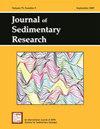Detrital signatures of clastic serpentinite in tectonically diverse settings and interpretation of an example from the Northern Apennines
IF 2.1
4区 地球科学
Q1 GEOLOGY
引用次数: 0
Abstract
Serpentine-bearing sediment, a rare sediment type that is formed and deposited in divergent, convergent, transform, and collisional plate-tectonic settings, carries important evidence of sediment provenance. Specific sources of serpentine-rich sediment display grain assemblages of distinct character that can be used to infer the serpentinization condition and sediment formation. This study reports quantitative and qualitative results on serpentine components in sandstones from Ocean Drilling Program Legs 149 (Iberia), 210 (Newfoundland), and 125 (Mariana and Izu–Bonin regions), and from serpentine-rich debris flows and arenitic breccias in deep-water successions in the Northern Apennine fold–thrust belt. We propose a textural scheme that offers a visual guidance for evaluating serpentinite grains that can be broadly adopted, is easily reproducible, and reduces user bias in determining compositional modes that allow comparison of serpentinite grain populations in arenites from different depositional environments, provenance, and associated tectonic settings. These data allow us to define a scheme for serpentine-dominated deposits that demonstrates the presence of two main groups of grain textures (pseudomorphic and non-pesudomorphic) with specific mineralogy and crystal shape as a function of temperature and pressure in the source rocks.The quantitative analysis of the serpentine-rich arenites and fine-grained sediments derived from forearc and rifted continental-margin settings shows that the studied samples are characterized by high percentages (c. ≥ 80%) of serpentine detritus and subordinate dense minerals and other lithic fragments, including basalt. In rifted continental-margin settings, the prevalent textures in serpentinite sandstones consist of polygonal mesh, mesh-core, and hourglass that all belong to the pseudomorphic category, which preserves the pre-serpentine features and mineralogy. These textures are typically formed in low-temperature conditions (< 390°C); lizardite is the most common mineral, along with minor chrysotile and, in rare cases, antigorite. In contrast, in forearc settings, serpentine-rich grain assemblages exhibit dominantly non-pseudomorphic, interlocking, and interpenetrating textures, dominantly composed of lizardite and recrystallization of lizardite by antigorite. Minor preserved ultramafic minerals related to dynamic recrystallization might be associated with the diapiric rise and protrusion of serpentine bodies.The Northern Apennines case study adopted to test this model indicates that the relationship of detrital serpentine texture to setting can be employed in provenance studies. Firstly, serpentine-bearing sediments derived from ophiolites deformed in fold–thrust belts have more variable serpentinite content, ranging from a few percent to < 10% for samples from deep marine environments, to typically c. 20 to ≤ 50% for stream and beach samples. This compositional variation arises from mixing of sediments derived from deeper to shallower oceanic lithosphere (peridotites and serpentinites) with material from overlying volcanic rocks and sedimentary cover. The deep-water serpentine-rich sands of the Northern Apennines display variable compositions with intermediate characteristics. The source of the serpentine-bearing deposits is interpreted to be a residual oceanic lithosphere characterized by subcontinental mantle-lherzolite originated in the Middle–Late Jurassic by mantle delamination. The serpentinite-dominated debris flows and sand beds contain serpentine grains that exhibit compositional and textural transitions from pseudomorphic to non-pseudomorphic categories, along with changes in mineralogy from lizardite to antigorite. Serpentinite with pseudomorphic texture is observed in the mantle section away from the deformed area. On the contrary, the presence of serpentine-rich arenites with dominant non-pseudomorphic textures suggests derivation from tectonized serpentine along fault scarps and or as products of serpentine diapirism.The detailed serpentinite texture scheme used to classify sand grains in this study includes pseudomorphic (often lizardite, minor crysotile) and non-pseudomorphic textures, with the latter attributed to temperature- and pressure-controlled recrystallization (often to antigorite) or shearing during or after serpentinization. For comparison of different detrital-serpentinite populations, a new ternary plot is proposed where counted parameters are grouped into three end members: undeformed, deformed, and recrystallized. This plot appears to discriminate different sources of detrital serpentine by tectonic setting (e.g., Iberia and Newfoundland margins vs. Mariana forearc) and shows the potential complexity of serpentinite sources in the Apennine basin example. Additional texturally based petrographic data sets are needed to determine the usefulness of this plot in provenance studies.不同构造背景下碎屑蛇绿岩的碎屑特征以及对北亚平宁山脉实例的解释
含蛇纹石沉积物是一种罕见的沉积物类型,在分异、汇聚、转换和碰撞板块构造环境中形成和沉积,是沉积物来源的重要证据。富含蛇纹石沉积物的特定来源显示出不同特征的颗粒组合,可用于推断蛇纹石化条件和沉积物的形成。本研究报告了大洋钻探计划第 149 站(伊比利亚)、第 210 站(纽芬兰)和第 125 站(马里亚纳和伊豆-波宁地区)砂岩中蛇纹石成分的定量和定性结果,以及北亚平宁褶皱推覆带深水演替中富含蛇纹石的碎屑流和海泡石中蛇纹石成分的定量和定性结果。我们提出了一种纹理方案,为评估蛇纹石晶粒提供了直观的指导,该方案可被广泛采用,易于复制,并减少了用户在确定组成模式时的偏差,从而可对来自不同沉积环境、产地和相关构造环境的 arenites 中的蛇纹石晶粒群进行比较。这些数据使我们能够为以蛇纹石为主的矿床确定一个方案,该方案证明存在两大类晶粒纹理(假形态和非假形态),其特定的矿物学和晶体形状是源岩中温度和压力的函数。对源自前弧和断裂大陆边缘环境的富含蛇纹石的砂岩和细粒沉积物进行的定量分析表明,所研究的样品具有蛇纹石碎屑比例高(约≥80%)的特点,其次是致密矿物和其他碎石,包括玄武岩。在大陆边缘断裂环境中,蛇纹石砂岩的常见纹理包括多边形网状、网状核心和沙漏状,它们都属于假形态类别,保留了蛇纹石形成前的特征和矿物学特征。这些纹理通常是在低温条件下(< 390°C)形成的;蜥蜴石是最常见的矿物,此外还有少量的温石棉,在极少数情况下还有锑榴石。与此相反,在前弧环境中,富含蛇纹石的晶粒集合体主要呈现出非假形态、交错和相互渗透的纹理,主要由蜥蜴石和蜥蜴石重结晶而成的锑榴石组成。与动态重结晶有关的少量保存下来的超基性矿物可能与蛇纹岩体的斜长上升和突出有关。为验证这一模型而采用的北亚平宁案例研究表明,在产地研究中可以利用蛇纹岩的岩理与环境的关系。首先,从褶皱推覆带变形的蛇绿岩中提取的含蛇纹石沉积物的蛇纹石含量变化较大,深海环境的样本中蛇纹石含量从百分之几到小于 10%不等,而溪流和海滩样本中的蛇纹石含量通常在 20%到 ≤ 50%之间。这种成分变化是由于从较深到较浅的海洋岩石圈沉积物(橄榄岩和蛇纹岩)与上覆火山岩和沉积覆盖层物质混合造成的。北亚平宁山脉富含蛇纹石的深水砂显示出具有中间特征的不同成分。据解释,含蛇纹石矿床的来源是残余的大洋岩石圈,其特征是起源于中-晚侏罗世地幔分层的次大陆地幔-蛭石。以蛇纹石为主的碎屑流和砂床中的蛇纹石颗粒在成分和质地上表现出从假形态到非假形态的转变,同时矿物学上也出现了从蜥蜴石到锑榴石的变化。在远离变形区的地幔剖面中,观察到具有假形态纹理的蛇纹石。相反,非假形态纹理占主导地位的富蛇纹石的存在表明,这些蛇纹石来源于沿断层疤痕构造的蛇纹岩,或者是蛇纹岩二叠纪的产物。本研究中用于对砂粒进行分类的详细蛇纹石纹理方案包括假形态(通常为蜥蜴石,少量为隐晶质)和非假形态纹理,后者归因于蛇纹石化过程中或之后受温度和压力控制的重结晶(通常为锑闪长岩)或剪切作用。为了比较不同的岩屑-蛇纹石群,提出了一种新的三元图,其中计数参数被分为三个末端成员:未变形、变形和再结晶。该图似乎可以根据构造环境(如伊比利亚和纽芬兰边缘与马里亚纳前弧)来区分不同的蛇绿岩碎片来源,并显示出亚平宁盆地示例中蛇绿岩来源的潜在复杂性。需要更多基于纹理的岩石学数据集,以确定该图谱在产地研究中的有用性。
本文章由计算机程序翻译,如有差异,请以英文原文为准。
求助全文
约1分钟内获得全文
求助全文
来源期刊
CiteScore
3.80
自引率
5.00%
发文量
50
审稿时长
3 months
期刊介绍:
The journal is broad and international in scope and welcomes contributions that further the fundamental understanding of sedimentary processes, the origin of sedimentary deposits, the workings of sedimentary systems, and the records of earth history contained within sedimentary rocks.

 求助内容:
求助内容: 应助结果提醒方式:
应助结果提醒方式:


